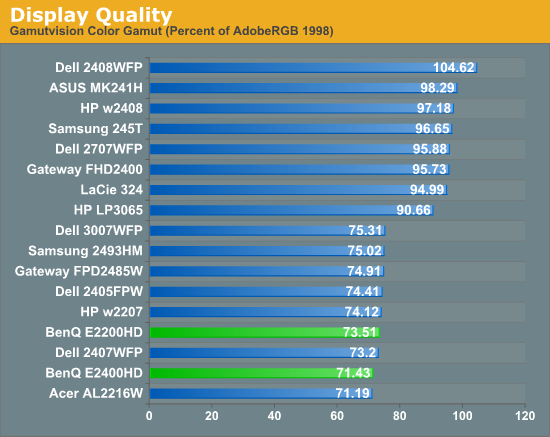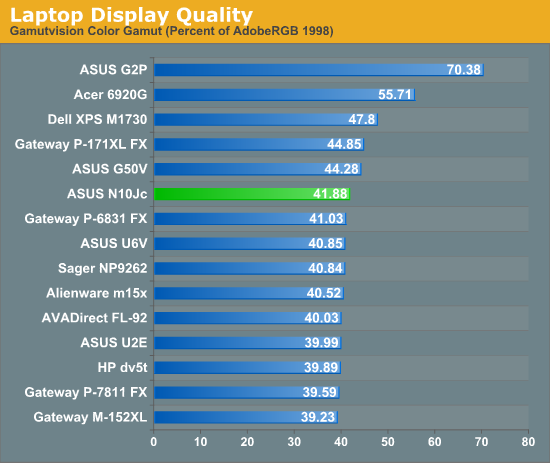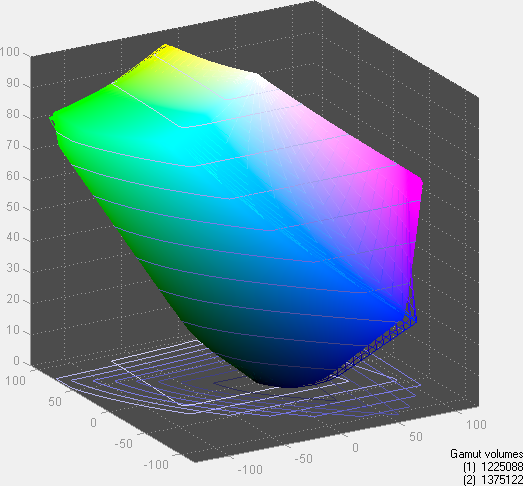Dell Studio XPS 16: Highest Color Gamut Ever?
by Jarred Walton on February 26, 2009 6:00 AM EST- Posted in
- Laptops
Okay, let's get something out of the way right off the bat: I started work on a review of the Dell studio XPS 16 before CES 2009. Originally intended to go live at CES, I decided to hold off in order to conduct additional testing and send some questions to Dell. Ultimately, we ran into some problems with the sample laptop, which is a prerelease version with a few kinks that need to be worked out. Ironically enough, the one major complaint in involves a glitch with the LCD on the unit we received, but we didn't notice this problem on any of the other studio XPS 16 laptops at the show. Anyway, I'm holding off on the full review until Dell can provide a retail sample, which should occur in the near future. In the meantime, one of the initial test results was shocking enough that I felt it was time for a blog. That's right: it's time to talk about laptop LCDs again!
When Dell claimed that the Studio XPS 16 would have the highest color gamut of any current laptop, I was a bit skeptical. I mean, the best color gamut I've seen up to now was on the ASUS G2P, which managed a rather impressive 70% of the Adobe RGB 1998 gamut. The next best LCD I've tested happens to be the Acer 6920G 1080P model, coming in around 55%. Everything else is roughly 45% or lower. On their own, such numbers don't necessarily mean a lot, so let's give a point of reference. Desktop LCDs from several years ago typically scored around 70% to 75% -- in other words the best laptop LCD I've tested to date might be able to match the entry-level desktop LCDs.
Here are a couple charts from the most recent reviews for laptops and LCDs showing how things stack up. To say that the laptop LCDs are uninspiring is a gross understatement.


As you might have guessed, the reason for this blog is that I was just putting together the results from the Dell Studio XPS 16. Given that it has a 16" LCD with a 1080P resolution, I assumed Dell was using the same LCD panel as the Acer 6920G. It's worth noting that there are two LCD models for the Studio XPS 16, so perhaps the less expensive version is the same as the Acer laptop. As for the more expensive LCD... well, have a look at the following color gamut chart (courtesy of Gamutvision).

It's not just that Dell has managed to close the gap with desktop LCDs; they have actually surpassed what many of the best desktop LCDs achieve! A color gamut of 112% of the Adobe RGB 1998 standard is extremely impressive. The "secret sauce" in this recipe for success is that Dell uses RGB LED backlighting instead of the standard white or yellow LEDs (or CCFLs) found in most LCDs. Obviously desktop LCDs have managed better color gamuts prior to now, but this is the first LED backlit LCD I've seen that actually manages to provide a good color gamut. That bodes well for the future of both desktop and laptop LCDs based on LED backlighting -- good colors and lower power requirements all in the same package.
Unfortunately, there are still some major gaps between desktop and laptop LCDs. The biggest one is the native panel technology; I still haven't managed to procure any laptops that use something other than a standard TN (twisted nematic) panel. That's entry-level desktop LCD technology, and while it's certainly cheaper, I prefer to spend the money on S-PVA, S-MVA, or S-IPS panels (in that order). Frankly, I would love to see any of those technologies utilized in a laptop LCD! (On a side note, if you get a desktop LCD and you plan to use it in portrait mode, you absolutely do not want a TN panel!) Panel technology also has a big influence on color quality, and so far none of the laptops I've tested come anywhere near what we see on a good desktop LCD. There are always spikes in delta E up to 5.0 or higher, and the Studio XPS 16 doesn't appear to change that.
Let's wrap things up with a little bit of polling, shall we? I have my opinions on how important a good LCD is when it comes time to purchase a new laptop, but I'm curious to hear your feelings on the subject. Let's not restrict things to just discussing LCD quality, though; I've put together several questions regarding LCDs. I'd love to hear your input, and if you have any other thoughts on the matter you can post below in the comments or drop me an e-mail.
{poll 121:1725}










91 Comments
View All Comments
tpurves - Thursday, February 26, 2009 - link
Wouldn't apple displays be the obvious ones to be comparing with here?Just about anyone significantly/professionally concerned about color accuracy is going to using an apple display or considering one right?
CK804 - Thursday, February 26, 2009 - link
Anyone concerned about color accuracy would be looking at professional displays with IPS panels from companies such as NEC, Lacie, and Eizo. Additionally, anyone concerned about color accuracy wouldn't be using laptop screens if they had a choice.strikeback03 - Friday, February 27, 2009 - link
Plenty of sports and reportage photographers have to process and upload their images almost immediately after they are taken, no time to go back to the office/home to edit. So yes, there is a market for high quality laptop screens.JarredWalton - Thursday, February 26, 2009 - link
You would think so... but then wouldn't there be a market for professional laptop LCDs as well? I think there is; I for one would appreciate an IPS laptop display with accurate colors!JarredWalton - Thursday, February 26, 2009 - link
Haven't managed to get a MacBook for testing from Anand, but I've seen them and they seem to rate around the level of the Acer 6920G - better than average but not perfect. Older MacBooks used S-IPS I hear (several years ago), which would have been awesome.ltcommanderdata - Thursday, February 26, 2009 - link
Well by MacBook, if you mean 13.3" MacBook, then they aren't that good. I'd be specifically interested in the new 17" Unibody MacBook Pro since Apple claimed during the launch that it has a new screen that offers their widest gamut ever in a Mac laptop. I don't believe the 15" MacBook Pro has this claim, so it's only the 17" model.garydale - Thursday, February 26, 2009 - link
Firstly, I don't like laptops. The keyboards and pointing devices are cramped and clumsy. And having the keyboard and screen connected means you have either the screen too low or the keyboard too high. They're just no good for doing real work.Secondly, despite the ongoing hype about them closing the gap with desktops, they are and will likely always be far behind desktops in terms of shear computing power. Moreover, you pay twice what a desktop costs for equivalent performance.
However, they do have their uses. I especially like the netbook idea of a small, long-lived and light weight computer for when you're not near your regular work environment(s).
My ideal laptop needs a wide screen to accommodate a decent size keyboard. Otherwise, I prefer the 4:3 aspect ratio for desktops. It needs lots of pixels, which again implies a decent size screen to be able to see what's on it. It needs to be light weight because I'll have to carry it around. But it also needs to able to run on battery power for hours on end even after years of use.
Do I need great colours on screen? Probably not.
Still, I can't wait to see this LED technology appear on desktop displays. I still use a CRT because LCDs just can't do what my old 21" Dell P1110 can do (1792 x 1344 - actually, it can do more but then the text gets too small, with more colours than any LCD). Sure it's heavy and uses too much electricity, but I don't move it, and nothings perfect.
Frallan - Thursday, February 26, 2009 - link
I would love to see good screens in range 17-20" at full HD res. But without the Oomph in the GFX and drive department it quickly becomes worthless.
Mastakilla - Thursday, February 26, 2009 - link
I'd rather have them make some more Normal Gamut Laptop LCDs then jumping on the stupid (and for 99.99999% of the people also completely useless) Wide Gamut crapstrikeback03 - Thursday, February 26, 2009 - link
So then what would these new Normal Gamut LCDs add over the crap that is currently available?